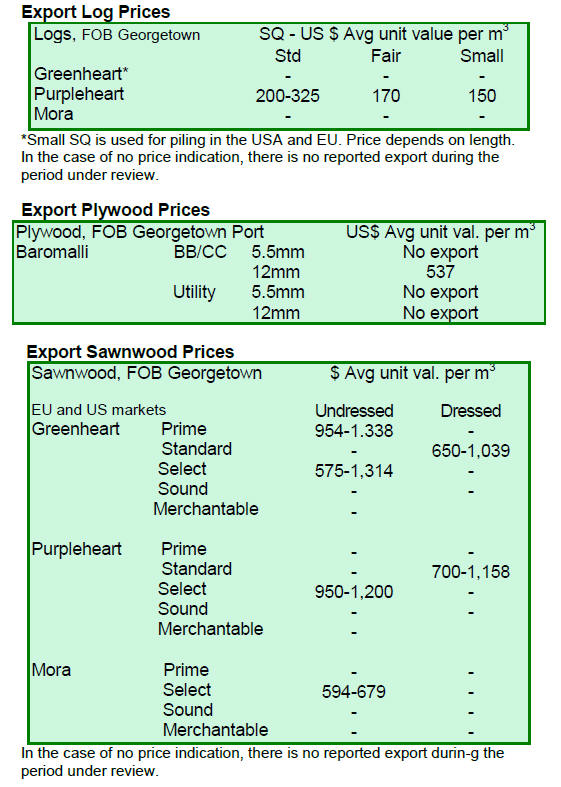2. GHANA
EU markets absorbing more of Ghana¡¯s
exports
Ghana‟s exports of secondary wood products (SWPs), for
the first quarter of 2014 accounted for 90% of total export
revenues according to available statistics from the Timber
Industry Development Division (TIDD) of the Forestry
Commission (FC).
Exports in the first quarter 2014 totalled euro 22.49
million compared to euro 29.48 million in the first quarter
2013. The term SWP in Ghana includes sawnwood,
veneers, boules and plywood.
Wawa, mahogany, cedrella, koto, makore and teak were
the major timbers exported during the first three months of
the year.
Markets in the EU accounted for 42% of total in the first
quarter, significantly higher than the 22% in the same
quarter last year.
Shipments to African markets slipped to 33% of all
exports from last year‟s quarter figure of 36%.
The Asian, American and Middle Eastern markets
accounted for the balance.
Ghana to issue first timber validity license in
2014
The Deputy Minister of Lands and Natural Resources, Ms.
Barbara Serwah Asamoah, has hinted Ghana could start
the issuing Timber Validity Licenses (TVL) for timber
exports to the European Union markets by the end of the
year.
She said this during a tour of some timber companies in
the Western Region of Ghana with the EU Ambassador in
Ghana Mr. Claude Maerten. The purpose of the tour was
to assess the country‟s preparation towards compliance
with the EU Voluntary Partnership Agreement (VPA).
Also in the group making the tour was Dr Ben Donkor, the
Executive Director of the Timber Industry Development
Division (TIDD) and Mr. Chris Beeko, Director in-charge
of the Timber Validity Department of the Forestry
Commission.
Ms. Asamoah said Ghana had initiated several processes
towards full compliance with the VPA, to pave the way for
Ghanaian companies to export verified legally harvested
wood products to EU markets.
On his part Dr. Donkor said the Division had positioned
itself to ensure compliance with the Voluntary Partnership
Agreement, while Mr. Beeko said the FC had put in place
a Legality Assurance System (LAS) to help track timber as
it moves through the supply chain.
Regional shipping line mooted
The Ghana Chamber of Commerce and Industry (GCCI),
jointly with other Chambers in the region, plans to
establish a shipping line to serve the regional trade.
Funds for the project are to be raised in the capital market,
from private investors and interested institutional
investors.
If the investments are forthcoming the new line will help
ease challenges faced by those dealing with the regional
trade and should boost intra-regional trade.

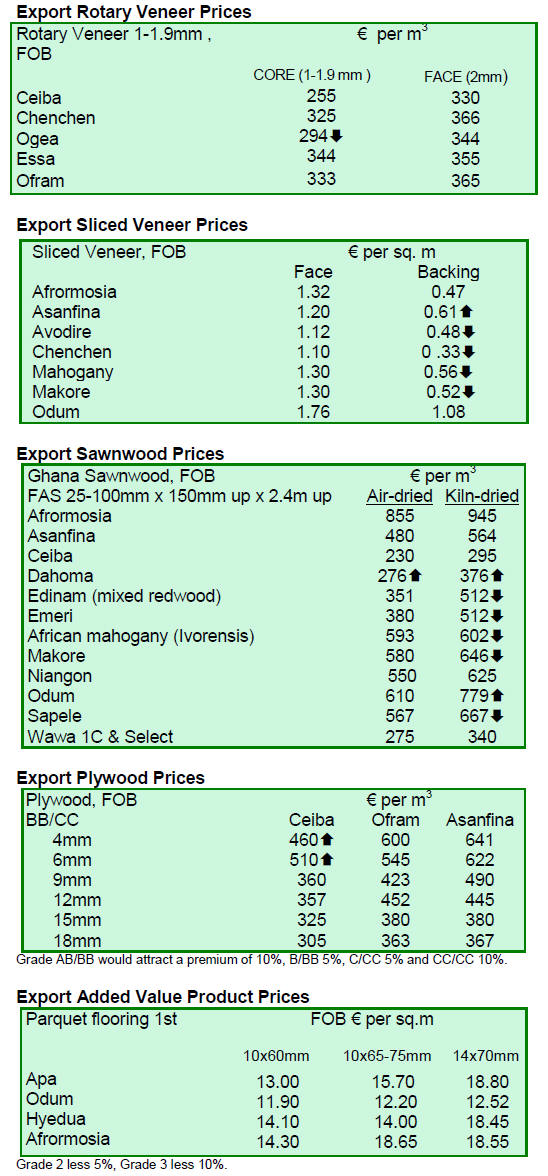
¡¡
3. MALAYSIA
VPA could be signed in 2015
Malaysia started negotiating with the EU in 2006 on a
Voluntary Partnership Agreement (VPA) under the EU
Forest Law Enforcement, Governance and Trade (FLEGT)
initiative.
Eight years later the EU-Malaysia VPA is still elusive
however, some 60 experts recently gathered in Kuala
Lumpur for two meetings one of which was the Joint
Expert Meeting of stakeholders from EU and Malaysia to
finalise the Malaysian Timber Legality Assurance System
(TLAS).
This was followed by a meeting of the Technical
Working
Group which looked into the various outstanding issues of
the TLAS and VPA terms.
The experts felt that all outstanding issues could be settled
in time for the VPA to be signed by Peninsular Malaysia
and Sabah in early 2015.
EU has VPA timeline for Sarawak
The Malaysia Reserve, an e-newspaper, reported the EU
Chief Negotiator, Hugo Schally, as saying ¡°the EU has
clear time bound commitments for Sarawak to sign the
VPA after Peninsular Malaysia and Sabah¡±.
Though the timelines are still under negotiation the EU is
proposing a three-year period for Sarawak to sign once the
EU-Malaysia VPA takes effect.
Data released at the meetings showed that timber and
timber products exported by Malaysia in 2012 were worth
RM 20.2 billion (approximately US$ 6.2 billion).
Of the total exports, Japan accounted for RM 4.2 billion
(21%), United States RM 2.5 billion (12.4%) and the EU
RM 2.1 billion (10.4%).
The EU organised an information sharing meeting after
the two official meetings. Stakeholders, including
representatives of the timber trade and NGOs/Civil
Societies were invited to be briefed on the EU Timber
Regulations, Due Diligence, legality definition and the
state of negotiation of the EU-Malaysia VPA.
India main buyer of Sarawak logs
Statistics compiled by Sarawak Timber Association for the
first quarter of the year showed Sarawak exported 650,368
cubic metres of logs worth RM441,613,268
(approximately US$135.9 million). By way of
comparison, the first quarter of 2013 saw an export of
749,044 cubic metres worth RM422.4 million.
Merantis‟ formed the biggest species group in first quarter
exports at 312,938 cubic metres (48%). The next main
species group was Mixed Light Hardwood (MLH) at
100,773 cubic metres (15.5%).
India was the biggest buyer of Sarawak logs at 419,822
cubic metres in the first quarter 2014 (64.6%) followed by
Taiwan (76,601 cubic metres or 11.8%). Japan is now the
fourth ranked importer from Sarawak at 31,488 cubic
metres or 4.8%.
Regional markets support sawnwood exports
Sawntimber exports from Sarawk for the first quarter of
2014 totalled 143,354 cubic metres worth RM132,130,730
(approximately US$40.7 million) with the biggest buyer
being the Philippines at 39,204 cubic metres (27.3%)
followed by Thailand at 30,071 cubic metres (20.9%) and
Yemen, 18,973 cubic metres or 13.2%.
The changes in the structure of the timber industry in
Japan are reflected in the pattern of imports. Previously
Japan was a major log importer and manufacturer of
tropical plywood.
This has changed, Japan imports less logs but more
tropical plywood, mainly from Sarawak. The table below
shows the main export markets for Sarawak plywood in
the first quarter of 2013 and 2104.
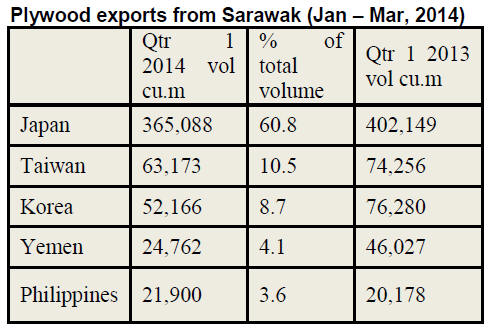
4. INDONESIA
Indonesia to issue new SVLK regulations
The Government of Indonesia will issue revised SVLK
regulations in June this year as it has just completed an
assessment and revision process. SVLK stands for ¡°Sistem
Verifikasi Legalitas Kayu¡±, Indonesia's timber legality
assurance system.
The revisions draw upon the results of the 2013
independent SVLK evaluation jointly conducted by
Indonesia and the EU, the subsequent Indonesia-EU action
plan to advance VPA implementation and multistakeholder
consultations held in February and March
2014.
See: http://capacity4dev.ec.europa.eu/publicflegt/
blog/indonesia-posts-draft-regulations-timberlegality-
assurance-comments#sthash.qjf8s4Uv
and
http://eyesontheforest.or.id/attach/Anti%20Forest%20Mafi
a%20Coalition%20%2818Mar14%29%20SVLK%20Flaw
ed%20FINAL.pdf
Self declaration for community wood certification
Forestry Minister, Zulkifli Hasan has said the ministry is
committed to encourage the use of wood raw material
from community forests and to achieve this the regulations
will be simplified.
For example the sale of timbers such as sengon, jabon or
wood from fruit trees from community land only require a
bill of sale (receipt) to be deemed legal.
Association membership brings benefits to small
companies
Small sized furniture producers in Jepara, Central Java,
have found advantages in coming together as an
association as their negotiating power has increased and
they are seeing improved earnings.
"By joining an association, individual craftsmen
know that
they can work more effectively with governments and the
private sector," said Herry Purnomo, head of a research
project at the Center for International Forestry Research
(CIFOR).
Indonesian teak furniture for Taiwan P.o.C
ORDER Furniture Corporation of Germany has retail
outlets in Taiwan and since 2010 the company has been
buying teak furniture from 5 manufacturers in Jepara and
Solo.
In 2013, the company purchased 84 containers of teak
furniture and plans to increase purchases this year. At the
end of May representatives from the company will be in
Indonesia to try and find more suppliers in order to meet
increasing market demand.

¡¡
5. MYANMAR
MTE¡¯s sales policy for 2014
The Myanmar Timber Enterprise (MTE) has released
details of its sales policy which came into effect on 1 April
this year.
The following is a non-legal translation provided by the
ITTO analyst in Myanmar. Interested parties are advised
to contact MTE for full details.
(a) Direct Sales Contracts
(1) No further selection and transportation of logs
will be allowed against direct sales contracts, as
export in log form is no longer permitted from 1st
April 2014.
(2) Whatever logs selected prior to 1st April 2014
and were left unshipped will be sold at contracted
prices if payments are made latest by 30
September 2014. The selected logs will return to
MTE if payment is not made by 30 September
2014.
(3) Payments will NOT be accepted from 1
October 2014 and all contracts will cease to be
operative.
(b) Contracts for supply of Industrial Raw (IR)
logs
(1) Payment for logs selected prior to 1 April
2014 will be accepted only up to 30 September
2014. Cargo will be delivered against Delivery
Order issued after payment has been made.
(2) No more supplies will be made against these
contracts. From 1st October 2014 industrial raw
material needs by the private sector will be met
by open tender sales.
(c) General
(1) All other teak and hardwood logs that are
depot balances that are not covered by the
above two types of sales will be sold by open
tender.
(2) Starting 1st October, all logs that unshipped
and unpaid will be taken back and MTE will
re-sell them in open tenders.
(3) Industrial raw logs sold by MTE can be
transported to the private mills and factories
only after full payment has been made.
(4) Earnest money will be confiscated if
payment for successful lots in the open
tender sales is not made within 60 days from
the date of sales. The lots will then be resold
in coming open tender sales.
Products manufactured from logs purchased in
Myanmar Kyats can exported
It has also been learnt that logs and sawn timber purchased
with the domestic currency from the local marketing and
milling branch of MTE can be exported if they meet the
following criteria.
The timber raw material must have been
purchased through the open tender system.
Export item shall not be in log form.
The timber must be further processed and then
inspected by the Forest Department (FD) and
MTE.
After this joint inspection the Forest Department will issue
a certificate.
To avoid misunderstanding in the interpretation of the new
rules interested parties are advised to seek clarification
from the FD and MTE.
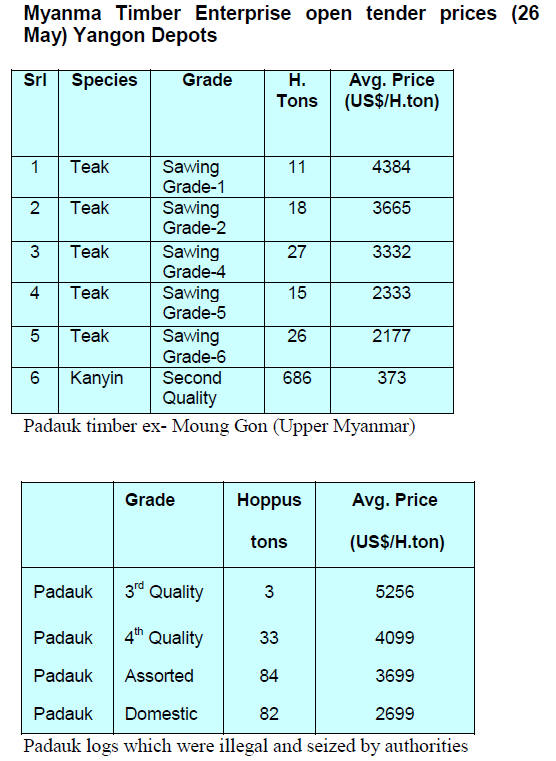
In addition 85 tons of various sizes of teak rough
sawnwood (including hand sawn timber) seized by
authorities were old by MTE on 23 May 2014. Total
revenue from this sale amounted to US$205,330.
Teak harvest reduced
It was reported in the Daily Eleven of 14 May that,
according to officials from MTE, only 60,000 tons of teak
will be harvested during this financial year.
Some will be utilised by the MTE mills and factories
which means there will be a reduction in the volumes
offered in the open tender sales.
6.
INDIA
Business sector says prospects look good
The election victory of India's opposition party has been
welcomed by the business community as the new central
government is expected to be more pro-business. Of
special interest is whether the new administration will
eliminate the controversial 2012 legislation that allowed
for retroactive corporate taxes.
The Bharatiya Janata Party (BJP) and its allies won more
than the 272 seats needed for a majority in Parliament and
has replaced the Congress Party.
India's business community is very happy say analysts as
the country will now have a stable government with a
business-friendly leader which could herald unprecedented
industrial growth.
Housing sector businesses, just as the rest of the business
community, have reacted positively to the BJP election
success and anticipate determined action to tackle inflation.
Wholesale Price Index rises stocking fears of further
inflation
The Office of the Economic Adviser (OEA) to the Indian
government provides trends in the Wholesale Price Index
(WPI). The official Wholesale Price Index for All
Commodities (Base: 2004-05 = 100) for the month of
April, 2014 rose by 0.2 percent to 180.2 (provisional) from
179.8 (provisional) for the previous month.
On inflation a press release from the OEA says ¡°The
annual rate of inflation, based on monthly WPI, stood at
5.20% (provisional) for the month of April, 2014 (over
April, 2013) as compared to 5.70% (provisional) for the
previous month and 4.77% during the corresponding
month of the previous year.
The build-up inflation rate in the financial year so far was
0.22% compared to a build-up rate of 0.71% in the same
period of the previous financial year.
For more see: http://www.eaindustry.nic.in/
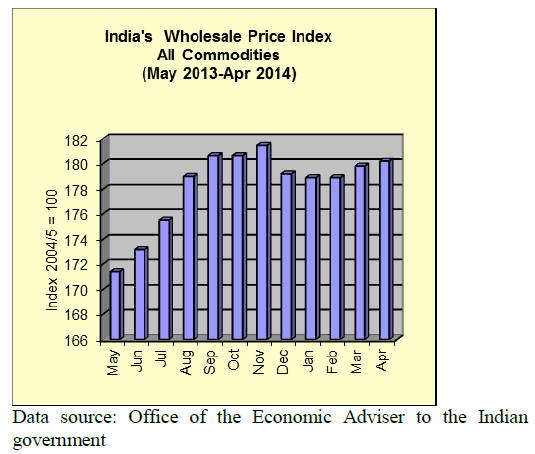
Timber and plywood wholesale price indices
In addition to data on the Wholesale Price Index for all
commodities, the OEA reports Wholesale Price Indices for
a variety of wood products.
The Wholesale Price Indices for Logs/timber and Plywood
are shown below. The April 2014 logs/timber index
increased from levels in March but the plywood index
remained flat.
The plywood price index for May is expected to be
significantly higher as the impact of the Myanmar log
export ban on veneer prices filters through to the market.
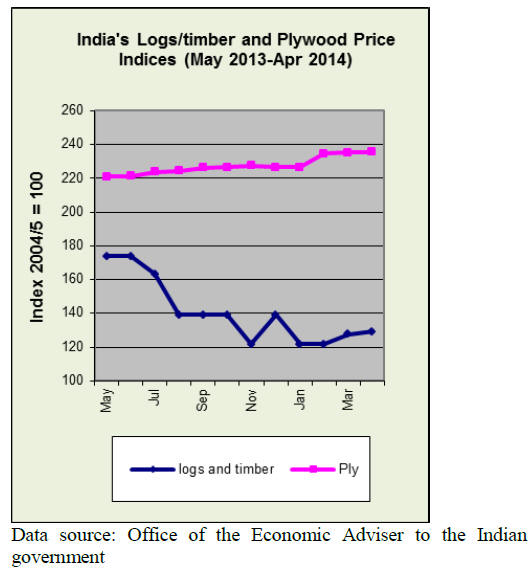
The Plywood Manufacturers Associations in Punjab,
Haryana, Gujarat, Kerala, Gandhidham have reported that
their members are facing sky rocketing prices of gurjan
face veneers.
The price of face veneers cut from gurjan logs
imported
from Myanmar before the log export ban has risen by 25%
to 50%. In the face of rising costs for gurjan face veneers
it would be expected that manufacturers would switch to
other species but that is not so easy in India.
Indian plywood users have been led to believe that red
coloured wood is stronger than other colour timbers. As
pointed out by analysts, ¡°the consumer needs to be more
rational, does the very thin face veneer of gurjan add to the
strength characteristics of the plywood? Not at all, it is
just a wrong notion that red coloured woods are stronger¡±.
However, in terms of marketing it will require a major
effort on the part of plywood manufacturers to convince
consumers that plywood with a pale timber face veneer is
just as strong as a red coloured veneer.
Those who have been in the plywood industry for years
recall that around 50 years ago no-one had heard of gurjan.
When it was first used for plywood the high resin content
was a serious problem in gluing veneers.
In the days when imported timbers were used for veneer,
pali (Pallanquium spp.), red cedar (Cedrela toona), white
cedar (Dysoxylum malabaricum), pandapine (Canarium
strictum), and mango (Mangifera indica) were the
favorites for plywood manufacture and none of these
timbers are dark red.
Indian importers feel the Myanmar log export ban should
have been phased which would have avoided the present
confused state of in the Indian plywood sector.
Imported plantation teak prices
Prices for plantation teak remained unchanged over the
past weeks and the flow of imports has been steady but the
impact of the log export ban in Myanmar will eventually
have a pronounced effect on the plantation teak market.
Over time the industry will be more dependent on
domestic teak resources and will slowly have to introduce
other tropical timbers as substitutes for Myanmar teak.
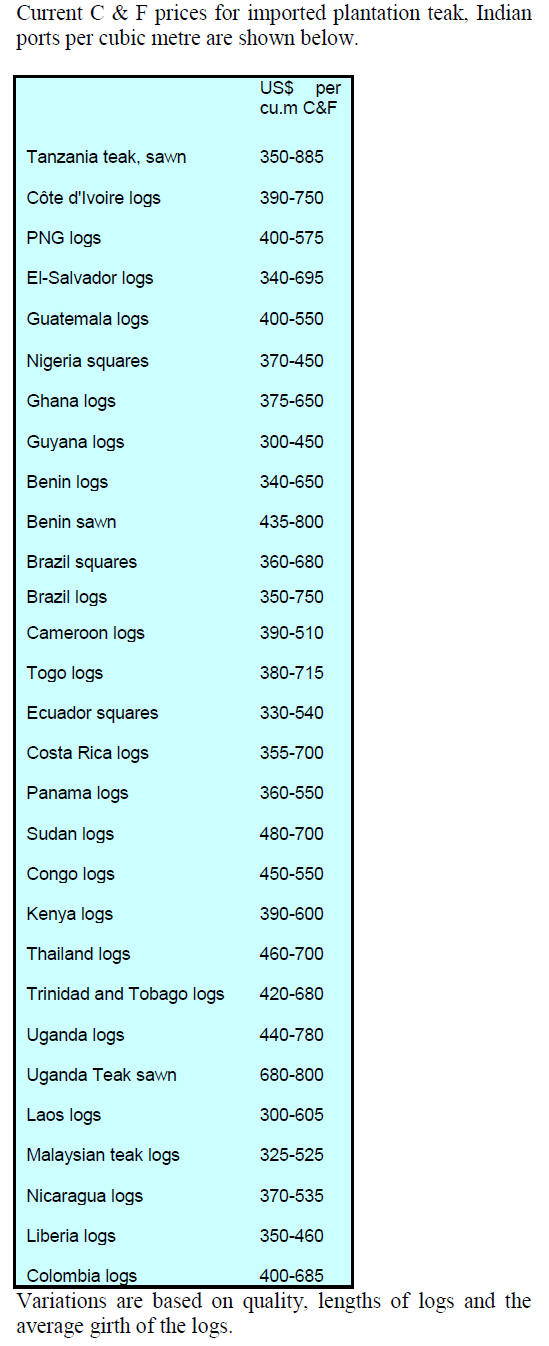
Imported sawnwood
Interest in non-teak tropical hardwoods is increasing as
Myanmar teak is becoming very expensive in the domestic
market as millers stocks of sawnwood cut form teak logs
imported before the log export ban in Myanmar run down.
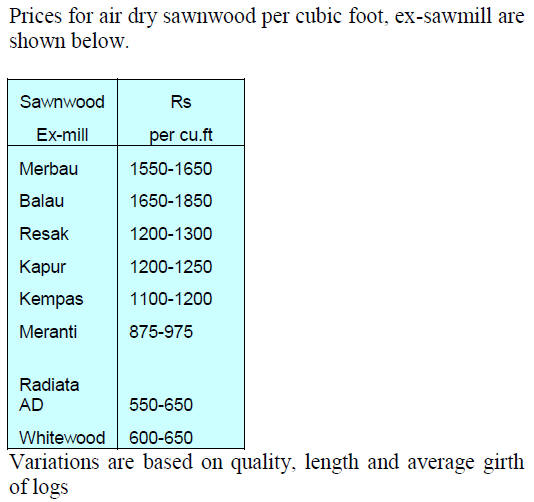
Balau, Kapur and Red Meranti are becoming more
popular
and demand for these timbers is strengthening.
Myanmar teak processed in India
Export demand for teak products processed in India is
steady and millers still have reasonable stocks according
to analysts. However, teak prices will continue to climb as
log stocks fall.

During May and June there are usually a series of
auctions
of domestic logs but, due to the elections, all auctions
were postponed. The auction programme for June is yet to
be announced.
Analysts report that the transport of logs from the forests
to the depots has been maintained so millers should be
able to secure adequate stocks when auctions resume to
see them through the monsoon season when logging stops.
Imported sawnwood prices
Ex-warehouse prices for imported kiln dry (12% mc.)
sawnwood per cu.ft are shown below.

In the current market situation, and if promotional
activities are conducted to reach out to endusers and
consumers, the demand for imported sawnwood should
expand to make up for the volumes previously produced
from Myanmar logs.
Plywood prices rise as gurjan veneer stocks fall
Almost all Indian plywood mills have been compelled to
increase prices. While demand in the main cities remains
subdued, housing and infrastructure developments in
second and third tier towns are keeping plywood makers
busy.
The new central government has plans to further expand
these new towns to ease the pressure in the housing market
in the main cities.
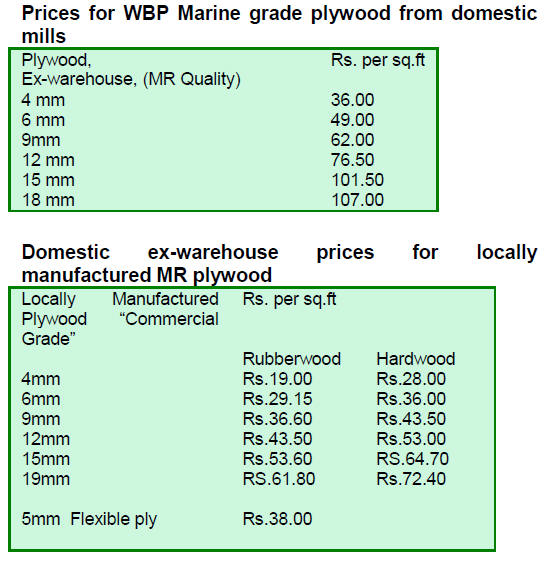
¡¡
7.
BRAZIL
Welcoming slowing of inflation
Brazil´s Consumer Price Index (IPCA) in April 2014 was
0.67% signalling a slowing of inflation compared to
March when the monthly rate of inflation was 0.92%. In
the first four months of this year the IPCA increased
2.86% compared to 2.5% in the same period last year.
In April 2014, the Monetary Policy Committee of the
Central Bank (COPOM) decided to increase the Selic rate
to a high of 11%.
Logging cycle can be reduced from 35 to 25 years
Brazilian forest regulations state that the logging cycle
shall be no less than 35 years and this applies to all natural
forest types.
Observers note that this cycle may be too long for some
regions and too short for others and that research is needed
to provide a sound basis for determining the logging cycle.
The Brazilian Agricultural Research Corporation
(EMBRAPA) has just published a study on the issue of
logging cycles "Strategies for Achieving Sustainable
Logging Rate in the Brazilian Amazon Forest" based on
assessment of forest management areas in Mato Grosso.
The study suggests that a 25-year cycle for timber
extraction of 30 cu.m/ha/year is appropriate for some
forest types rather than the current 35 years.
According to the Timber Industry Union of Northern Mato
Grosso State (SINDUSMAD), six native Amazon tree
species were studied and the ideal logging cycle is
different for each one. This study will provide a basis to
review the current 35 year cycle defined in the forest
regulations which also have a minimum diameter rule of
30 cm for all species.
Further work will be conducted to recommend different
diameter classes for various species.
Increased exports of tropical sawnwood
In April 2014, wood product exports (except pulp and
paper) increased 1.4% in terms of value compared to April
2013, from US$217 million to US$220 million.
Pine sawnwood exports increased 35% in value in April
2014 compared to April 2013, from US$14 million to
US$18.9 million. In terms of volume, exports rose 27.8%,
from 64,400 cu.m to 82,300 cu.m over the same period.
Tropical sawnwood exports increased 6.9% in volume,
from 26,200 cu.m in April 2013 to 28,000 cu.m in April
2014. In value, exports increased 3.6% from US$14
million to US$14.5 million over the same period.
Pine plywood exports expanded 4.4% in value in April
2014 compared to April 2013, from US$36.4 million to
US$ 38 million. The volume of exports increased 6.6%,
from 95,900 cu.m to 102,200 cu.m, during the same
period.
On the other hand, tropical plywood exports fell 17% from
4,100 cu.m in April 2013 to 3,400 cu.m in April 2014. In
terms of value, tropical plywood exports fell 16%, from
US$2.5 million in April 2013 to US$2.1 million in April
2014.
Wooden furniture exports fell marginally in April from
US$ 38.8 million in April 2013 to US$38.2 million in
April 2014.
Amazon Fund invests in sustainable practices
The Amazon Fund plans to fund activities to strengthen
environmental initiatives in Acre state. Specifically the
Fund will support a project ¡°Valuation of Environmental
Forest Assets¡± which will include work on integrated land
management, measures to promote forestry and
agroforestry production chains and technical and financial
incentives for environmental services.
Acre state policies are considered a model in terms
of
sustainable development. According to the Secretariat of
Agroforestry Extension and Family Production
(SEAPROF), the support for the project by the Amazon
Fund will boost the contribution to the economy in Acre
from sustainable forest production and will also help
reduce deforestation and environmental degradation.
This project seeks to introduce sustainable practices to
small family producers to generate economic alternatives,
food security and increased income.
Brazilian exports via Pacific coast to become a reality
The state government of Mato Grosso do Sul has invested
US$13.7 million in the construction of two bridges that
will connect Porto Murtinho and Caracol municipalities
(Mato Grosso State in Brazil) to Vallemy and São Carlos
municipalities (in Paraguay).
Completion of these bridges will facilitate transport of
agricultural, forestry and steel products from Brazil to
ports of Chile.
The shortest way for Brazilian products to reach Chilean
ports for shipment to Asia, the main importer of grains and
pulp from Mato Grosso, is Porto Murtinho (Brazil),
Mariscal Estigarribia (Paraguay) Tupiza (Bolivia) and
Iquique (Chile).
The new route will be some 900 km shorter than the 2,700
km. route that crosses Bolivia. The bridge (180 metres)
between Porto Murtinho and Vallemy will cost R$8.2
million and the bridge (120 metres) between Caracol and
San Carlos will cost about R$ 5.5 million. Construction
will begin in July and the bridges should be completed by
year end.
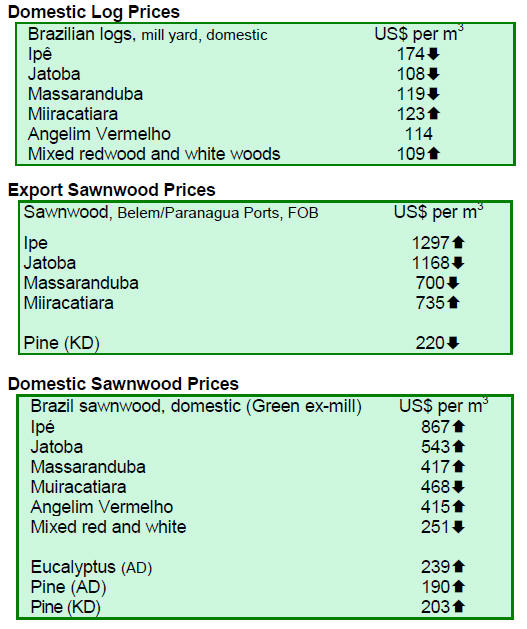
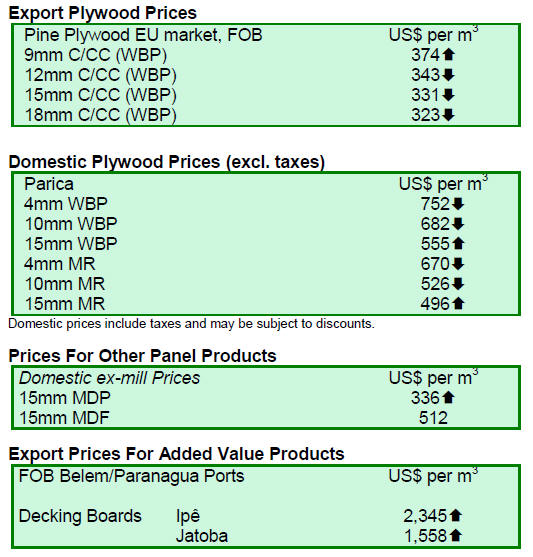
8. PERU
Forest products certification
The College of Engineers of Peru, Ucayali, SCS Global
Services and the Forest Products Association of Ucayali
(Aprofu) recently concluded a workshop on certification
of wood products in an effort to promote forest
certification amongst entrepreneurs, professionals,
technical advisors as well as indigenous communities in
the Peruvian Amazon.
The Workshop aimed to promote and strengthen the
technical capacity of forest management and chain of
custody in the context of forest certification.
SMEs to produce school furniture
In the framework of the "Purchases Myper¨²", established
by the local Fund for Social Development (Foncodes),
twenty micro and small enterprises in the Ucayali region
will receive orders for the production of 5,000 folding
chairs to be used in public schools.
Seeking a recovery of the forestry sector
The Forest Products Association of Ucayali (Aprofu), the
Roundtable for Sustainable Forestry Development Ucayali
(MCDFSRU) region, the National Forestry and the Forest
Department and Wildlife (DGFFS) conducted a series of
meetings during the first four months of this year to
contribute to the recovery of the forest sector.
Breaking the poverty trap
Cesar Peñaranda, an official from the Lima Chamber of
Commerce has said „¡±around one million people will
escape from poverty in Peru if the country‟s economy
posts a growth rate of over 5.5 percent¡±.
Currently around 25 percent of the population in Peru live
below the line of poverty according to a recent report from
the National Statistics Institute.
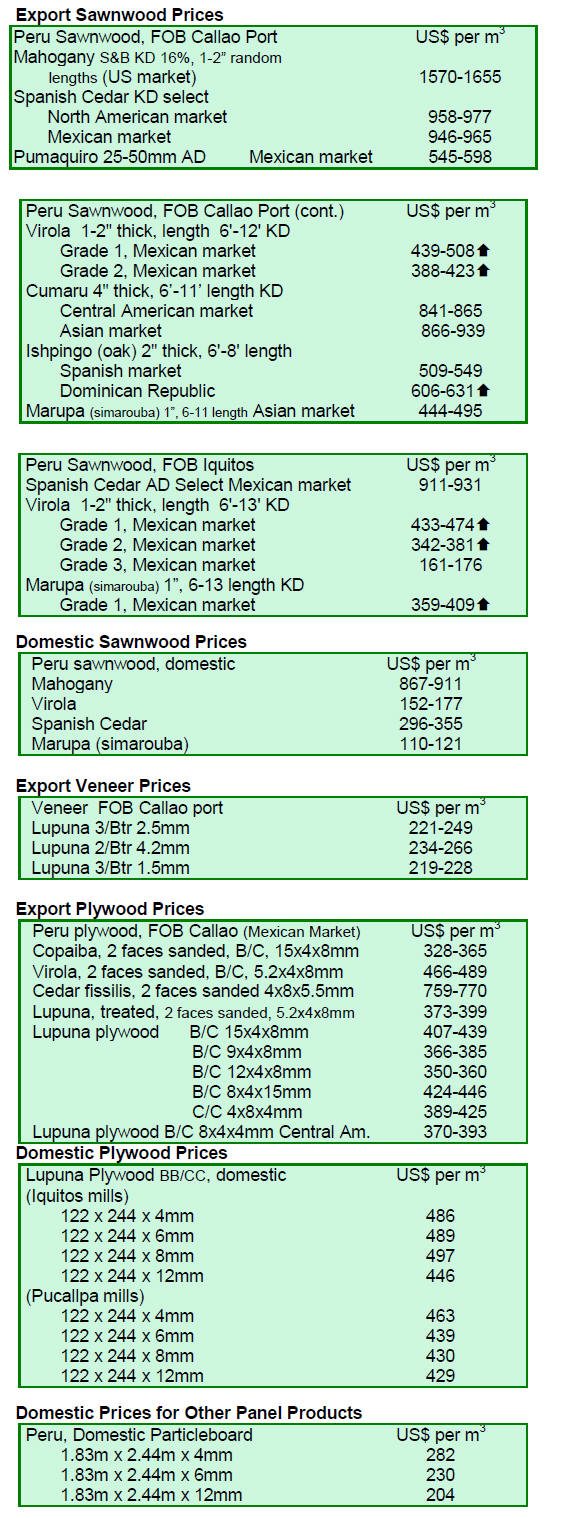
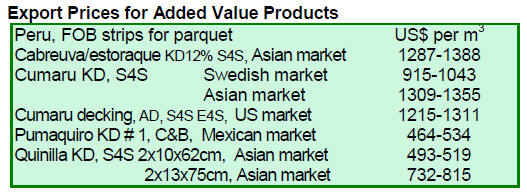
¡¡
9.
GUYANA
Wamara logs proving popular
There were no exports of greenheart logs in the period
reviewed however, purpleheart Standard Sawmill quality
logs attracted a favourable top end FOB price of US$325
per cubic metre.
Fair Sawmill quality purpleheart log FOB prices remained
at US$170 per cubic metre while Small Sawmill quality
logs were traded at US$150 per cubic metre FOB. Mora
log prices were unchanged, except for Standard Sawmill
Quality logs which earned US$120 per cubic metre FOB.
Wamara (Swartzia leiocalycina) logs are becoming more
popular and prices have moved up for all categories.
Standard Sawmill quality wamara logs were traded at
US$210 to US$215 per cubic metre FOB, Fair Sawmill
quality logs attraced a price of US$125 to US$210 per
cubic metre FOB while Small Sawmill quality log FOB
prices moved up to US$120 to US$200 per cubic metre.
Weaker Caribbean market for dressed greenheart
Sawnwood exports were active and attractive prices were
earned on the export market. Undressed greenheart (Prime
quality) commanded a price as high as US$1,338 per cubic
metre FOB and was shipped to buyers in the Middle East
and Oceania.
Undressed greenheart (Select quality) was sold at a
significantly higher price than recently earning as much as
US$1,314 per cubic metre FOB in Caribbean, European
and North American markets.
Undressed purpleheart sawnwood prices remained stable
at US$1,200 per cubic FOB while, in contrast, Undressed
Mora Select category earned a favourable price as high as
US$679 per cubic metre FOB in Caribbean markets.
Despite the overall positive price movements Dressed
greenheart prices in Caribbean markets declined
marginally from US$1,158 to US$1,039 per cubic metre
FOB. Dressed purpleheart sawnwood FOB prices held
firm at US$1,158 per cubic metre FOB.
Guyana made plywood was traded at a fair price earning
as much as US$537 per cubic metre FOB in the North
American market.
Splitwood (shingles) attracted a significant FOB price
earning as much as US$1,341 per cubic metre in
Caribbean and North American markets.
Select quality greenheart piles continue to earn
attract
favourable market prices ranging from US$350 to
US$1,043 per cubic metre FOB. Sound category
greenheart piles were traded at prices ranging from
US$298 to US$438 per cubic metre FOB in North
American and European markets.
Community harvesting plan supported by GEF
Kaburi, with a population of 275 people, primarily
Akawaio and Patomona descendants, occupy an area of
41.57 square miles. Kaburi Village, located along the
Bartica-Potaro Road in Region 7 (Cuyuni/Mazaruni)
received a grant of US $3.4m from the Global
Environment Facility (GEF) to ensure the sustainable
management of the forest.
The capital of Region 7 is Bartica, with other major towns
including Issano, Isseneru, Kartuni, Peters Mine, Arimu
Mine, Kamarang, Keweigek, Imbaimaidai, Tumereng and
Kamikusa.
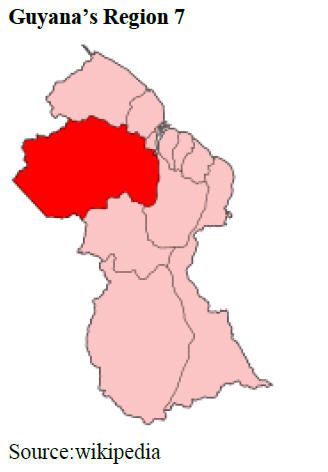
The funding will support development of a timber
harvesting plan for the village and has been provided by
the Global Environmental Facility (GEF) Small Grants
Programme (SGP) that provides financing directly to civil
society, community-based and non-governmental
organizations to design and implement projects that will
bring environmental and livelihood benefits to
communities.
The SGP is implemented by the United Nations
Development Programme (UNDP) and executed by the
United Nations Office for Project Services (UNOPS).
The village of Kaburi was established in 1935 and recently
received land title from the Government of Guyana. Some
residents are involved in small scale timber harvesting and
the Kaburi Village Council had requested assistance to
implement a forest management project they can sustain in
the village.
